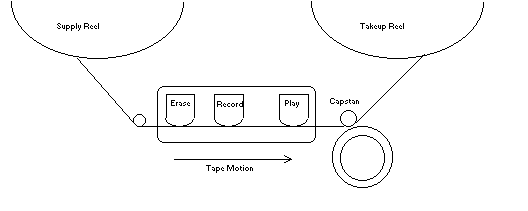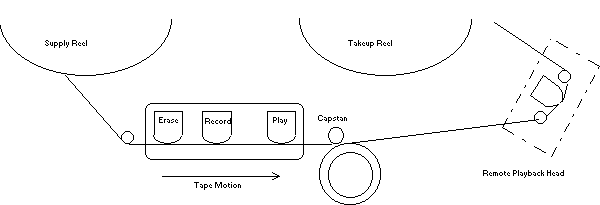| Someone commented that analog tape, and the sonic characteristics of tape delay have a unique quality that is difficult to simulate with digital electronics. This is true, and there is nothing like the real thing.
It isn’t difficult to begin experimenting with analog tape looping. First, go to a pawn shop or similar source and obtain a used tape machine. The best likely candidates for looping modifications are machines with three-head, three-motor design and electronically operated transport controls. Many excellent and rugged machines of this type were made in the 70’s and early 80’s by TEAC, Tascam, Pioneer, Revox, and Akai. If you find one of these formerly very expensive units, you will probably be able to purchase it for $200 or less. They are now aging, but the best ones were built to last, and can become completely operable with minor maintenance and cleanup.
There are two ways to modify the machine into a looper.
- Way 1 is to add another playback head, separated from the record head by a significant distance.
- Way 2 is to increase the tape distance between the existing record and play heads.
Way 1 is described here. If you observe the tape path, you will note that the tape is fed out by the supply reel on the left side, first passes across the erase head, then the record head, then the playback head, before entering the capstan / pinch-roller assembly, and then is wound onto the take-up reel on the right. It is not necessary to use an actual “loop” of tape to create the audio looping function, because the audio loop is formed electronically by feeding part of the playback head’s output into the recording input.

The concept that creates musically useful loops is a relatively wide separation between the record and playback heads.
- The easiest way to do this is to get another playback head, preferably from a junked tape recorder (i.e., cheap). Take the playback head and mount it on a board along with two of the tape guide posts from the junked tape recorder. The guide posts are necessary because the tape must cross the playback head in a very precise alignment in order for this to work.
- Open up the head assembly on the working tape recorder and disconnect the wiring from the rear of the playback head. You will need a small soldering iron to accomplish this. If you don’t have one, get a techie friend to help out. You will need to obtain a length of cable similar to the cable you have disconnected from the playback head. It will probably have four conductors and a braided shield. Ten feet is a good length to start with (too long a cable will cause audio problems). It’s got to be shielded cable. Connect the new wire to the remote tape head, and splice to the end of the wire in the good tape recorder. You must make sure that the connections from the rear of the new tape head go to exactly the same wires as the original head did.
- Position the remote tape head assembly on a solid support some distance away from the tape recorder, to the right and at the same level as the transport deck. Doing this works best if you have the tape recorder on its back on a tabletop. The tape feeding out of the capstan / pinch roller goes out through the first extra guide, across the remote playback head, through the second guide, and back onto the take-up reel.
- You can test the new setup by putting a pre-recorded tape in place, and listening to the output.

Note: Because you have altered the tape path significantly, the machine will not work correctly in fast-forward and rewind modes. To use these modes, remove the tape from the remote head and let it feed through the machine normally.
To begin looping, you must establish an electronic path from the tape machine’s output to its input. The easiest way to do it is with an external mixer. Simply include the line out of the tape machine as one of the inputs to the mixer, and connect the mixer’s output to the tape-machine input.
You will have created a true stereo looper, and the loop-delay time is regulated by the distance from the record head to the remote playback head. At a tape speed of 7.5 inches/sec., 10 ft of separation translates to 16-sec. loop time; 5 ft = 8 sec., etc. Cutting the tape speed in half doubles the loop time (just like digital!). An added benefit is that your looping creations are automatically and permanently recorded for you.
Aside from a couple of days of scrounging around pawn shops, the project should take only a few hours to complete. Hope this inspires some new musical ideas, alone or in combination with modern effects / devices.
The first looper I ever made was done using the above technique. I was 14 years old and my parents had bought me my first “real” tape recorder. It was a Panasonic mono half-track that ran at 7.5 and 3.75 speeds and was compact enough to move around easily. I’d had my hands on borrowed ones, etc., but with this one I felt that I could begin accumulating a collection of my own musical ideas. And I began to do exactly that. At some point I wanted to experiment with delay and echo. I didn’t want to cannibalize or modify my prize machine, so when I set up a remote head, I ran the output of it through my Fender guitar amplifier (don’t I wish I still had this ’65 pre-CBS Twin Reverb — yes!), and then somehow part of the output of the amp back into the tape recorder. In fact, the amp served as guitar input device, mixer, and playback monitor all at once.
The hi-fi aspect of this arrangement was questionable, to put it mildly (I’m sure I used a cheap pb head too...), but that added to the nice weirdness I encountered as the loops built up. It was one of the first instances of me being able to produce TRULY WEIRD sounds from my guitar. I had built electronic modifiers, etc., (FM tremolo, fuzzes, choppers, tone benders, etc.), but what came out of the tape recording setup was like some warped soundtrack from sci-fi. I finally learned to control it and work within the parameters to make what I could think of as music, as opposed to just noises.
So I’d like to think of some experimenters out there being able to experience what the tape-thing is all about first-hand. After all, tape is certainly the medium that inspired this genre.
More articles by Pat Kirtley:
Baking Tapes | The Case of the Squeaking Tape
|







